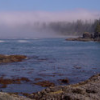The unofficial BC Travel & Tourism Guide
Clayoquot Sound

Clayoquot Sound occupies a straight-line distance along the coast of 90 kilometers, between Barkley and Nootka Sounds. It reaches a maximum of 35 kilometres inland, up to the crest of snow-capped mountains. These mountains are part of the central spine of Vancouver Island and form the headwaters of the rivers that drain Clayoquot Sound.
Modern History of Clayoquot Sound:
Summer of 1993: it what was destined to become the largest case of civil disobedience in Canadian history, 726 people were arrested at the Kennedy River bridge, the focal point for a logging controversy that had been simmering in Clayoquot Sound for about a decade. The price of breaking the court order against blocking the logging road was hefty, with an average jail sentence of 21 days.
For their efforts, in 1995 the province created a scientific panel to make recommendations on how and where to log the sound. The result has been an average drop in the amount logged from 400,000 cubic metres a year before the panel to as little as 100,000 cubic metres today.
In the Spring of 1993, the Clayoquot Sound Land Use Decision more than doubled the amount of parkland in the sound, adding parks to the Megin River watershed, upper Shelter Inlet, Sydney Inlet and outer coastal areas including the Hesquiat Peninsula, Flores Island and Vargas Island.
The result is almost unbroken protection of the open oceanfront in the sound. Combined with Pacific Rim National Park and previously created parks along Juan de Fuca Strait, the land use decision created a bridge of parks extending from the south entrance of Nootka Sound to China Beach near Jordan River, northwest of Sooke. Efforts to protect old growth forests, their water-ways and wildlife continue.
Industrial activities such as logging and fish farming have occurred and continue to occur across the landscape and ocean waters of Clayoquot Sound, but most of the Sound is still wilderness - intact forest and wild ocean. The spectacular scenery attracts about one million tourists to Clayoquot Sound each year.
Just click on the following links for more information about nearby communities such as







